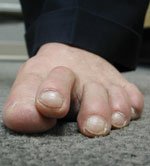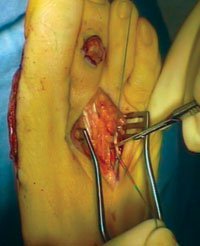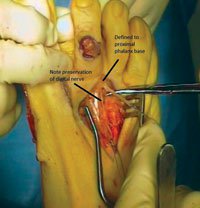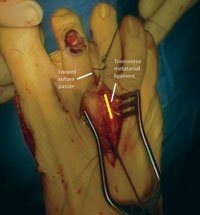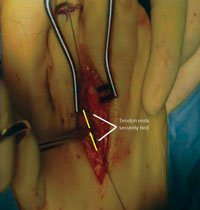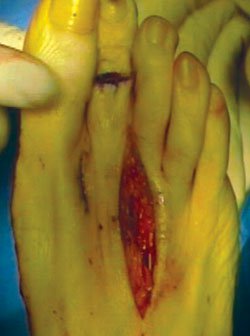Extensor digitorum brevis transfer for crossover toe increases motion, while avoiding complications
The crossover toe deformity, defined by sagittal and/or horizontal plane instability of the second toe, is a variant of a clawtoe or hammertoe deformity. Patients with a crossover toe may also present with a hammertoe or clawtoe component (Figure 1). However, if they are treated for a hammertoe or clawtoe in isolation without the ligament instability about the metatarsophalangeal joint being addressed, recurrence of deformity is common.
Theories as to the etiology of this instability often involve rupture or attenuation of the lateral collateral ligament and volar plate of the involved metatarsophalangeal joint, as well as a deficient plantar plate. This instability leads to a progressive shift medially of the proximal phalanx upon the metatarsophalangeal joint. The magnitude of shift is graded, which allows predictive value in implementing certain modalities (tendon transfers and/or osteotomies) to reproduce an anatomic alignment of that joint. Thus, to supplement for this plate deficiency while counterbalancing the tendon deformation, tendon transfer techniques have been implemented — with the extensor digitorum brevis tendon transfer and flexor-to-extensor tendon transfer considered to be the best options currently available. The extensor digitorum brevis tendon transfer is useful in the earlier grades of deformity, before the metatarsophalangeal joint experiences a rigid deformity or complete dislocation. In the latter instances, the flexor-to-extensor transfer and/or distal metatarsal osteotomies are generally used.
Thompson and Deland reported their results following flexor-to-extensor tendon transfer in 13 feet in 1993. They found that there were few patients who felt this was a great operation after it was complete, with the most common complaint being stiffness; and we know that pain directly correlates with stiffness in this patient population.
|
Image: Haddad SL |
Dynamic tendon transfer
My colleagues and I developed the extensor digitorum brevis transfer about 11 years ago as an alternative to the flexor digitorum longus tendon transfer. We believed this dynamic tendon transfer had significant value in preservation of the metatarsophalangeal joint, while avoiding complications such as avascular necrosis, malunion and stiffness. We had aimed to create an operation that would stabilize the attenuated plantar plate and lateral collateral ligament, while allowing for satisfactory range of motion, thereby increasing patient satisfaction.
I begin by making a long incision in the dorsum of the foot. The incision should begin just distal to the metatarsophalangeal joint, on its lateral side, and extend 5 cm proximal to the midportion of the foot. The latter point is critical, as technical challenges present when the surgeon does not expose the extensor brevis tendon proximal enough. Under those circumstances, the end-to-end anastomosis becomes more difficult to achieve following tendon re-routing.
I dissect the dorsal digital nerves free and avoid them throughout the procedure to preserve postoperative sensation (another source of irritation is parathesias about this nerve). I then define the extensor digitorum brevis to the musculotendinous junction proximally, placing two stay sutures on either side of the proposed sectioning of tendon with permanent suture.
Transverse metatarsal ligament
The tendon is then sectioned (Figure 2) and defined distally to its insertion into the proximal phalanx, freeing it to the extensor hood distal to the transverse metatarsal ligament. Be sure to free it up as an independent tendon so that it can be passed deep to the transverse ligament without interference from adjacent structures, but be sure to leave it attached distally (Figure 3).
|
|
|
A useful method to prevent rotation (supination) of the toe is to anchor the tendon inferiorly at the base of the proximal phalanx with permanent suture. By bringing the brevis tendon inferior and plantar while holding the toe rotated into pronation, it can be sutured securely in place to the base of the proximal phalanx capsule, eliminating any supination-directed force across this tendon when the transfer is performed.
Also of note, when defining the transverse metatarsal ligament, be careful not to confuse it with the intermetatarsal fascia, which will often be seen more superiorly. Passing the brevis tendon more superiorly will result in a superficial transfer of no value, as the superior fascia lacks the structural integrity of the transverse metatarsal ligament.
Stripping the volar plate
The medial collateral ligament and dorsal capsule of the metatarsophalangeal joint is completely sectioned, and care is taken not to violate the plantar plate. The volar plate is stripped at its origin using a McGlamry elevator or gouge, thereby allowing the plate to scar to the metatarsal proximal to its insertion. This will further assist with stability.
The lateral collateral ligament should then be examined for rupture, which is common. If attenuation is present, all redundant tissue is excised at this time. In either case, permanent sutures are placed in a figure eight fashion to repair the lateral collateral ligament, tightening it securely. Please note that the sutures are not to be tied at this time.
If hammertoe is present, a minimal resection of the distal condyle of the proximal phalanx and the proximal condyle of the middle phalanx is performed to stimulate proximal interphalangeal joint fusion or arthroplasty.
Tendon passage
A lamina spreader is used to place tension on the transverse metatarsal ligament between the involved metatarsal heads. Once again, be careful to not mistake the dorsal fascia for the transverse metatarsal ligament.
I then place a 90° clamp or aneurism needle from proximal to distal, deep to the transverse metatarsal ligament (Figure 4). The extensor digitorum brevis tendon can be passed from distal to proximal deep to the transverse metatarsal ligament by grasping the stay sutures previously placed at the tip of the tendon. Now, tie the sutures that were previously placed to repair the lateral collateral ligament.
|
|
|
Relieving tension
While holding the metatarsophalangeal joint in reduction, the toe is pinned with a 0.062 K-wire across the joint. This pinning is effective in relieving some of the tension from the lateral collateral ligament repair by placing the toe in some valgus and plantarflexion. The tendon transfer can now be tied end-to-end, completing the anastomosis (Figures 5 and 6).
To complete the procedure, the tourniquet is decompressed to assess vascularity of the digit prior to incision closure. More commonly, when the clawtoe deformity is severe, we no longer use a tourniquet in order to allow constant feedback on the vascularity of the digit. A layered closure is performed using 4-0 Monocryl (Ethicon, Inc.) and 4-0 nylon. I tend to remove the pin at 6 weeks postoperatively, leaving the toe taped into slight valgus across the base of the proximal phalanx for an additional 6 weeks, crossing this tape on the plantar foot — not to the adjacent digit.
|
|
Modifications
We first described this procedure in 1999 and compared our results with those of patients who had undergone flexor-to-extensor transfer. A comparison of postoperative range of motion at the metatarsophalangeal joint between the groups, showed significantly greater stiffness for the flexor-to-extensor group.
Following the introduction of this procedure as an alternative to flexor-to-extensor transfer for crossover toe correction, one main technical complaint among surgeons has been the difficulty in performing an end-to-end anastomosis with the extensor digitorum brevis tendon due to the tension created by the increased distance required by the re-routing. This concern was addressed by Lui and Chan, who have since described a modification of our extensor digitorum brevis tendon transfer technique. Their technique incorporates the extensor digitorum longus tendon into the transfer by passing it through a drill-hole in the proximal phalanx base, anastomosing it to the extensor brevis tendon proximally.
The extensor brevis transfer technique is appropriate for correcting mild to moderate crossover toe deformities. Although the technique avoids the risks of metatarsal osteotomy — malunion, nonunion and subsequent joint arthritis — it is not without limitations. It is appropriate for stage 1, stage 2 and flexible stage 3 deformities. It is not applicable in rigid stage 3 and stage 4 deformities, or for patients with a symptomatic neuroma of the second web space where the transverse metatarsal ligament is sectioned as a part of that procedure. Flexor-to-extensor tendon transfer is more appropriate for these cases.
References:
- Haddad SL, Sabbagh RC, Resch S, et al. Results of flexor-to-extensor and extensor brevis tendon transfer for correction of the crossover second toe deformity. Foot Ankle Int. 1999;20(12):781-788.
- Lui TH, Chan KB. Technique tip: Modified extensor digitorum brevis tendon transfer for crossover second toe correction. Foot Ankle Int. 2007;28(4):521-523.
- Thompson FM, Deland JR. Flexor tendon transfer for metatarsophalangeal instability of the second toe. Foot Ankle. 1993;14(7):385-388.
- Steven L. Haddad, MD, can be reached at the Illinois Bone and Joint Institute, LLC, Glenview Medical Arts Building, 2401 Ravine Way, 2nd Floor, Glenview, IL 60025; 847-998-5680; email: slhaddad@earthlink.net.
- Disclosure: Haddad has no relevant financial disclosures.

